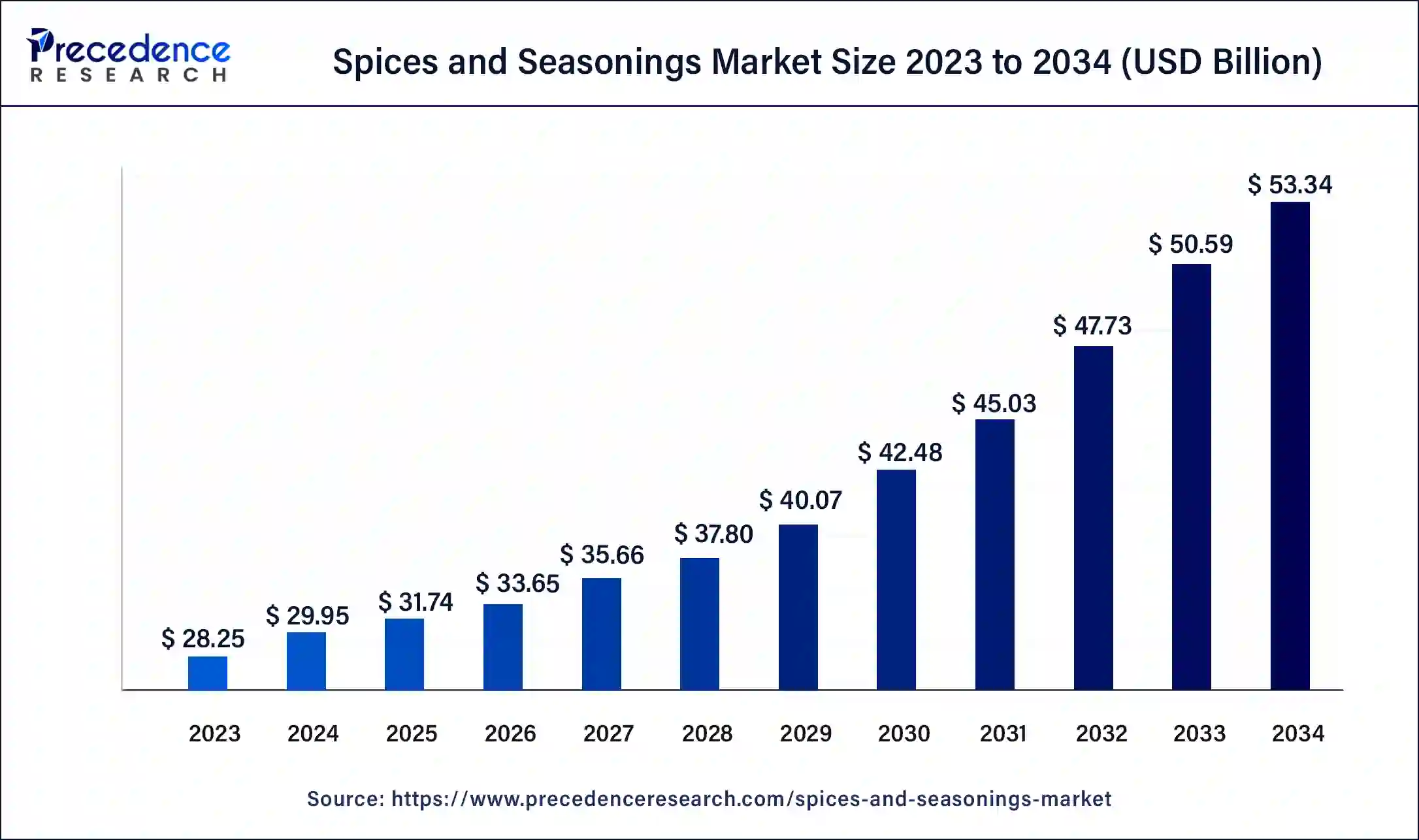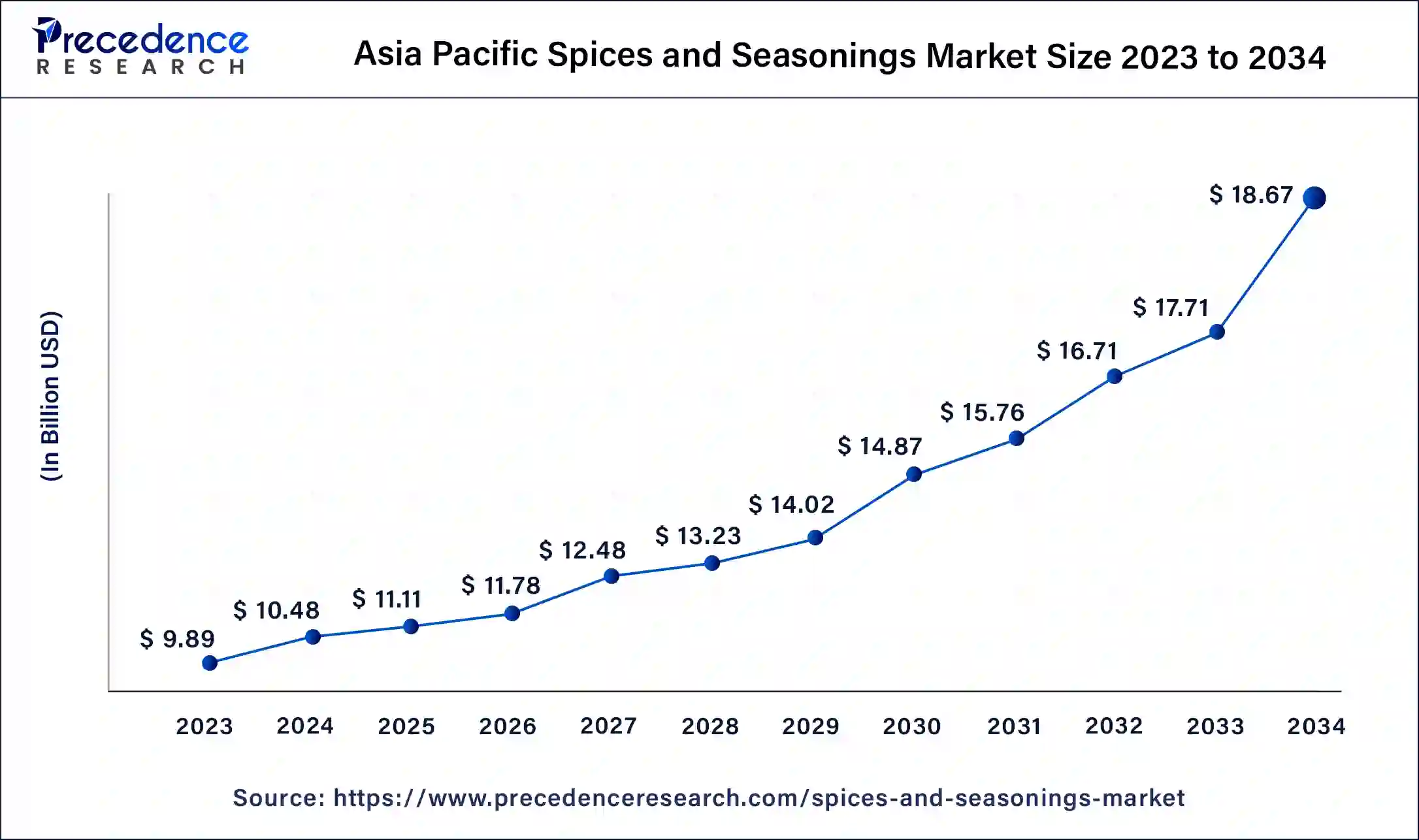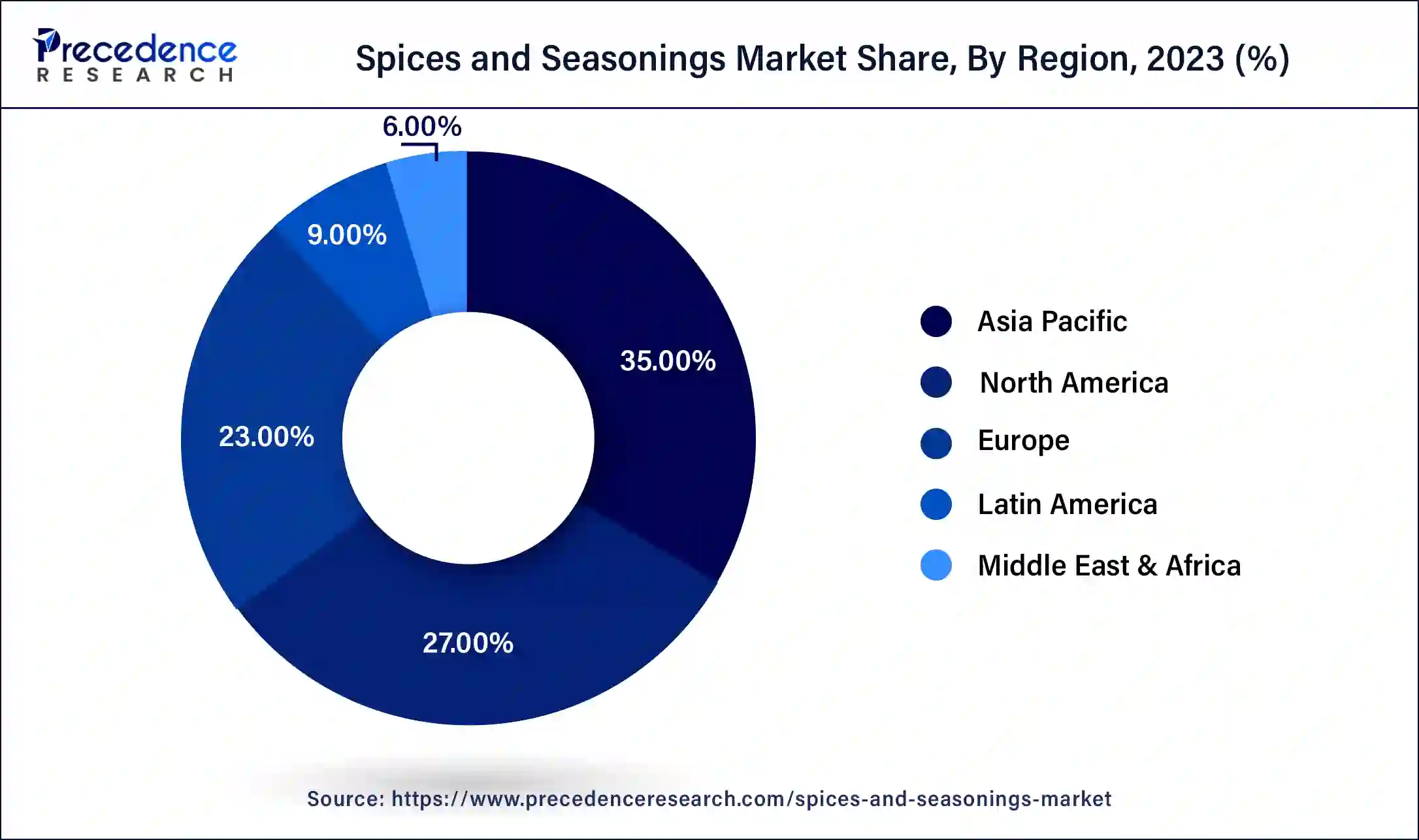The global spices and seasonings market size was USD 28.25 billion in 2023, estimated at USD 29.95 billion in 2024 and is anticipated to reach around USD 53.34 billion by 2034, expanding at a CAGR of 5.94% from 2024 to 2034.
The global spices and seasonings market size is estimated at USD 29.95 billion in 2024 and is predicted to reach around USD 53.34 billion by 2034, expanding at a CAGR of 5.94% from 2024 to 2034.

The Asia Pacific spices and seasonings market size was valued at USD 9.89 billion in 2023 and is predicted to be worth around USD 18.67 billion by 2033, at a CAGR of 6.20% from 2024 to 2033.

Asia Pacific region accounted for the largest market share in 2023. Significant nations contributing essentially towards the development of the district incorporate China, India, Japan, Australia, and New Zealand. The quickly developing cheap food industry and youthful demography in the Asia Pacific district have prompted an expansion in the utilization of bundled, frozen, and accommodation food, as would be considered normal to improve the development of the market for spices and seasonings.

Europe is the quickest developing business sector during the figure time frame in the spices and seasonings market. Factors like the enormous populace and the developing interest for valid ethnic spices, the rising prevalence of comfort food sources, and the developing consciousness of the restorative properties of spices and seasonings are driving the North American market.
The spices and seasonings are broadly used to add flavor, fragrance, variety, and taste to food and refreshments, and here and there likewise as additives or antibacterial specialists. Comfort food makers utilize these traits of spices and seasonings to further develop their item quality and taste and increment their time of usability. Customer readiness to explore different avenues regarding new spices and expanding interest in ethnic preferences has created a multiplication in item contributions and an expansion in the offer of spices and seasonings. The progress of this industry can likewise be credited to its reaction to customer interest for better items, comfort, and an assortment of spices.
The significant patterns impacting the spices and seasonings market are the expansion popular for handled meat and comfort items, clean names progressively becoming required, and an ascent in inclination for regular ingredients and spices. Shoppers are starting to put more worth on food sources that offer them help other than taste, and thus, interest in solid, regular, and safe food items is on the ascent.
An expanded inclination for western cooking and a social blend in food space has uplifted the interest for spices and spices as zest extricates. As spices are a significant gathering of enhancing specialists, zest blends have turned into an imminent portion for developments. Another excellent explanation reinforcing the interest for flavor mixes and spices is the changing buyer inclination, wherein a remarkable interest has been created in worldwide and ethnic food. The headway of epitome has prompted its application in pretty much every area of the food and refreshment industry. A comparative sort of use design has likewise been seen in the spices and seasonings market. A portion of the critical makers in the flavor and scent industry has been benefiting from the flavor variations in embodied designs. European interest inspices and seasonings is expected to enroll the most elevated CAGR of 6.8% over the gauge period. The chief end clients of spices and spices in all EU markets can be partitioned into three portions: modern, retail, and catering. In practically all EU nations, the biggest extent, being 55%-60% (and in certain nations much a greater amount of) the all-out utilization of spices and spices, is consumed by the modern area. The retail area consumes 35%-40% and the providing food area, 10%-15%. In many business sectors, the proportion moves towards higher relative utilization by the modern area, mirroring the developing ubiquity of prepared-to-utilize spices and seasonings combinations.
The novel Covid-19 pandemic had fundamentally affected practically all enterprises across the globe. This pandemic has brought about large-scale manufacturing closures and inventory network interruptions, which has impacted the economy too.This sickness has a variable effect in various nations relying upon their social standards, moderation endeavors, and wellbeing framework, and every nation is resolving its method for battling against the pandemic. Be that as it may, different examination studies are expressing the utilization of specific spicesthat could support our insusceptibility which could assist us with battling goliaths Covid as well as numerous different infections.In the ongoing situation, it has become critical to support the resistance to battle Covid, alongside keeping up with the cleanliness and following all clinical warnings that have been set down. Indeed, even the rules given by World Health Organization (WHO) in its COVID-19 examination recommend the total populace eats resistant helping food varieties. Consequently, the interest for restorative spices separates conveying properties of helping human resistance is at the flood in the drugs and nutraceuticals industry.
The overall lockdown, in any case, has additionally impacted cultivating rehearses, which has exceptionally affected the stock of unrefined components of spices and seasonings. The COVID-19 effect on planned operations additionally adds to the expanded costs of unrefined components, which supports the expense for restorative spices and seasonings makers. With hindrances to cross-line transportation of wares in this pandemic circumstance, makers are exceptionally reliant upon neighborhood unrefined substance providers, which expands the bartering force of providers. Subsequently, the expanded natural substance costs, trailed by the appeal for spices and seasonings, would prompt an expanded cost of restorative spices and seasonings for the following couple of years.
| Report Coverage | Details |
| Market Size by 2034 | USD 53.34 Billion |
| Market Size in 2023 | USD 28.25 Billion |
| Market Size in 2024 | USD 29.95 Billion |
| Growth Rate from 2024 to 2034 | CAGR of 6% |
| Largest Market | Asia Pacific |
| Base Year | 2023 |
| Forecast Period | 2024 to 2034 |
| Segments Covered | Type, By Application, Nature, Form, and Distribution Channel, and Region |
| Regions Covered | North America, Europe, Asia-Pacific, Latin America, and Middle East & Africa |
Rising trend of culinary experience
The rising trend of culinary experiences significantly contributes to the growth of the market. As people explore diverse cuisines and flavors, they seek out a wide range of spices and seasonings to enhance their dishes. This demand for unique an exotic flavor has driven the market, prompting manufacturers to offer a variety of options to cater to consumer preferences. Additionally, the popularity of cooking shows, food blogs and social media platforms has further fueled this trend. Many television channels have started food shows that offer culinary experiences. This inspires individuals to experiment with different ingredients and create their own signature dishes, consequently boosting the demand for a diverse range of spices and seasonings.
Disruptions in global supply chain
Global supply chain disruptions can majorly impact the spices and seasoning market by causing delays in sourcing and distributing products. Fluctuations in transportation availability, increased shipping costs and customs-related issues can lead to supply shortages and price volatility. This can affect the ability of manufacturers and retailers to maintain consistent product availability, potentially leading to dissatisfied customers and reduced sales. Additionally, these disruptions may necessitate adjustments in sourcing strategies, which can lead to higher procurement costs and complexity in managing suppliers from various regions. Thus, the element associated with the supply chain is observed to hinder the market’s growth.
Expanding food industry
The expanding food industry across the globe creates a significant opportunity for the global spices and seasonings market. As new food products are being developed and introduced, there is a need for a wide variety of spices and seasonings to cater to diverse consumer preferences. This expansion includes the growth of restaurants, ready-to-eat-meals, packaged foods and culinary innovation, all of which require high-quality spices and seasonings to enhance taste and appeal. By aligning with the trends and demands of the evolving food industry, the spices and seasonings market can position itself for greater market penetration.
Fluctuations in agricultural practices
Fluctuations in agricultural practices can be a major challenge for the global spices and seasonings market. These fluctuations can lead to inconsistent crop yields and quality, making it challenging for suppliers to maintain them as a steady and reliable source of raw materials. Variations in weather conditions, pest infestations and diseases can all impact the quantity and quality of the final product. Moreover, unpredictable agricultural practices can result in price volatility due to supply shortages and surpluses. This can lead to increased costs for manufacturers and potentially higher prices for consumers, affecting the overall demand for spices and seasonings.
Based on type, the ginger fragment represented the biggest portion of 38% of the worldwide flavor market in 2023. Most spices have the biggest piece of the pie in the Asia Pacific. This is because more spices are utilized in warm environments because of their antibacterial properties that free food sources of microorganisms and accordingly add to human wellbeing, life span, and regenerative achievement.
The quickly developing cheap food industry and expanding interest in comfort food have prompted an expansion in the interest for spices and seasonings like paprika, pepper, oregano, mint, and sesame. As far as utilization, the interest in turmeric has forever been high and is further expanding, particularly in Asian nations because of the restorative properties of turmeric and its broad use in Ayurvedic medications and Indian cooking styles.
The meat and poultry fragment represented the biggest offer in the worldwide flavor market in 2023. It represented a portion of 27% in 2023 and is projected to develop at a CAGR of 4.6% during the estimated time frame. Refreshments structure the quickest developing use of spices and seasonings, and this section is projected to develop at a CAGR of 7% somewhere in the range of 2024 and 2033. The rising populace, changing way of life patterns, and the ascent of extra cash of individuals, especially in creating economies like China, India, and Brazil, has prompted expanded utilization of bites and accommodation food things.
Based on nature, the worldwide spices and seasonings market is fragmented into natural and customary. Among the two, the regular section represents a higher-worth offer inferable from its simple accessibility at reasonable costs for its objective clients. Be that as it may, during the figure time frame, the natural configuration of spices and seasonings is supposed to acquire a more elevated level of footing, enlisting a critical development rate regarding deals.
Segments Covered in the Report
By Type
By Application
By Nature
By Form
By Distribution Channel
By Geography
For inquiries regarding discounts, bulk purchases, or customization requests, please contact us at sales@precedenceresearch.com
No cookie-cutter, only authentic analysis – take the 1st step to become a Precedence Research client